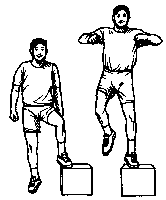Looking for a way to take your sports performance to a new level? You are already doing intervals and sprints. You have a regular weight-training regime. Then what’s next is Plyometrics. Plyometrics is a type of exercise designed to build muscular power. In my engineering training, I learned that power is the measure of doing work over time. So power is the measure of not just strength but the ability to apply strength quickly. Muscular power gets you off the starting line quickly, accelerate up the hill, or bound over an unexpected obstacle.
Plyometrics was originally known as "jump training." You’ll see why. One of the best definitions I’ve read comes from another web site.
Plyometrics is any exercise where the muscle is contracted eccentrically then immediately, concentrically. In plain English, the muscle is stretched (i.e. loaded) before it is contracted. A good example is push-ups with a clap in-between each push-up. Your muscle (pectorals in this case) is elongated and loaded by the downward force of your body, then immediately you must contract the muscle to push yourself back up.
Before you go jumping off the back steps to gain a bit of advantage over your weekend warrior friends, a few words of warning. Do not attempt a plyometrics training program unless you have first laid down a good base of fitness and strength through regular cardiovascular (aerobic) and weight-training. Although plyometric exercises vary in intensity, some are quite strenuous. Injury is likely if you don’t follow that advice. Wear good supportive shoes and always warm-up before doing the more intensive exercises.
Here is what Liz’s book Advanced Inline Skating says…
Delay introducing plyometrics drills until you have suffficiently built-up your tendons and muscles through resistance training to withstand the high impact forces. Avoid plyometrics training altogether if indicated by your age, current fitness level or injury history (when in doubt, check with your family doctor or a personal trainer who knows you well.)
A few tips
If you are ready to add Plyometrics to your workout routine, I have a few tips.
- Warmup adequately before doing the more intense exercises.
- Perform 2-4 sets of each exercise.
- Allow sufficient time for recovery.
- 1-2 minutes between sets
- 48 hours between workouts
- No more than 2 workouts a week.
Skate-Specifc Exercises
Here are some high-intensity, skate specific drills to incorporate into your Plyometrics routine. The descriptions are adapted from Jumping into Plyometrics by Donald Chu, PhD. The illustrations are from Liz’s book, also originally adapted from Dr. Chu’s book. I recommend Jumping into Plyometrics if you want to learn more about the theory of Plyometrics. It also describes and illustrates a wide variety of exercises and provides guidance on how to set up a program.
I start out doing low-intensity exercises such as jump-rope and walking lunges before I move to the more strenuous ones. The artwork below was adapted from Donald A. Chu's book Jumping Into Plyometrics.

Lateral Step-up
Using a 6 to 12 inch high box, start standing to the side of the box. Place the foot closest to the box on top. Use the leg on the box to raise the body until the leg is extended, then lower to the starting position. Don’t push off the foot on the ground; use the bent leg to do all the work. Perform the exercise using both legs.
One-Foot Zig-Zag Hops
Using two parallel lines, 24 to 42 inches apart and 10 meters (yards) long, start balanced on one foot on a line. Jump from one line to the other in a continuous forward motion for 10 meters, always taking off and landing on the same foot. Do not double hop at the touchdown. Perform on each foot.
Lateral High Hops
Using a 12 to 24 inch high box, start standing to the side of the box with the left foot raised onto the middle of the box. Using a double arm swing, jump up and over the other side of the box, landing with the right foot on top of the box and the left foot on the floor. This drill should be done in a continuous motion, shuffling back and forth across the box.
Two-Foot Zig-Zag Hops
Using two parallel lines, 24 to 42 inches apart and 10 to 15 meters (yards) long, start with feet shoulder width apart, straddling a line. Jump from one line to the other in a continuous forward motion, always taking off and landing on both feet. Do not double hop at the touchdown.
References
Books
Advanced Inline Skating byLiz Miller
Jumping into Plyometrics by Donald Chu, PhD.
Speed on Skates by Barry Publow
Web Sites
MadRaven - Introduction to Plyometrics